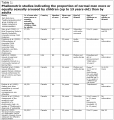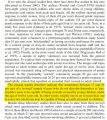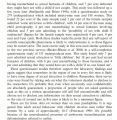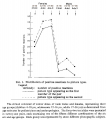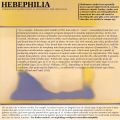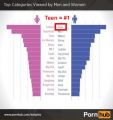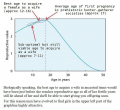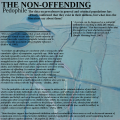Research: Prevalence: Difference between revisions
The Admins (talk | contribs) No edit summary |
The Admins (talk | contribs) |
||
| (22 intermediate revisions by 3 users not shown) | |||
| Line 1: | Line 1: | ||
__NOTOC__{{research}} | __NOTOC__{{research}} | ||
Evidence concerning the prevalence of [[pedophilia]] in the general population is limited, methodologically disparate and inconclusive. Studies using phallometry have found that most men show at least some arousal to prepubescent children, with a significant minority demonstrating a clear preference. We do know that when expanding the definition of pedophilia to encompass | Evidence concerning the prevalence of [[pedophilia]] in the general population is limited, methodologically disparate and inconclusive. Studies using phallometry have found that most men show at least some arousal to prepubescent children, with a significant minority demonstrating a clear preference. We do know that when expanding the definition of pedophilia to encompass attraction towards ages as high as 12 or 13 (i.e. "pedohebephilia"), phallometry consistently suggests that around 20% of men are equally or more aroused by "children".<ref name="Schuster" /> As [[James Kincaid]] says: | ||
<blockquote>''A recent study of ideal desirability using a computer program called FacePrints found that "the ideal 25-year-old woman ... had a 14-year-old's abundant lips and an 11-year-old's delicate jaw." that small lower face providing also the prominent eyes and cheekbones of children. We are told to look like children if we can and for as long as we can, to pine for that look.''<ref>[http://libgen.is/book/index.php?md5=3FC2825F3DCE1EC49CC4594E698A746C Erotic Innocence - The Culture of Child Molesting] by James R. Kincaid; Duke University Press, Durham, North Carolina, USA; Paperback edition: 2000; First edition: 1998</ref></blockquote> | |||
Further, the number of preferential hebephiles and ephebophiles is likely to be at least 10 times that the number of pedophiles.<ref name="Schuster">[https://www.ipce.info/sites/ipce.info/files/biblio_attachments/every_fifth.pdf Schuster - "Every Fifth" Combination of Studies]</ref> According to Michael Seto and the DSM-5, the actual prevalence of ''Pedophilic Disorder'' is unknown, with an estimate of up to 3-5% (American Psychiatric Association, 2013).<ref>[https://www.theravive.com/therapedia/pedophilic-disorder-dsm--5-302.2-(f65.4) DSM-5] or [https://www.docdroid.net/qSmIApN/dsm20v-pdf#page=717 Exact Copy (paraphilia)] or [https://www.docdroid.net/qSmIApN/dsm20v-pdf#page=729 Exact Copy (pedophilic disorder)].</ref><ref>[https://www.bbc.com/news/magazine-28526106 BBC Quote Seto on 5% upper estimate.]</ref> Evidence concerning women is for all practical purposes, absent (see this page and [[Research: Pedophilia as a sexual/erotic orientation|our adjacent review on "orientation"]] for that limited information). | |||
==Prevalence of attraction to minors== | ==Prevalence of attraction to minors== | ||
*'''[https://www.humanrights.unsw.edu.au/sites/default/files/documents/Identifying%20and%20understanding%20child%20sexual%20offending%20behaviour%20and%20attitudes%20among%20Australian%20men.pdf Identifying and understanding child sexual offending behaviours and attitudes among Australian men - UNSW Report] (Nov, 2023)''' | |||
*:"Would have sexual contact with a child between 12 to 14 years if no one would find out '''(5.7%)'''" | |||
*:Would have sexual contact with a child between 10 to 12 years if no one would find out '''(4.6%)'''" | |||
*:Would have sexual contact with a child younger than 10 years if no one would find out '''(4.0%)'''" | |||
*:''The Guardian'' adds: "The report found nearly one in six men (15.1%) had sexual feelings towards under 18s."<ref>[https://www.theguardian.com/australia-news/2023/nov/20/child-sexual-abuse-study-finds-94-of-australian-men-report-having-offended-against-a-child One in 10 Australian men report having sexual contact with under-18s, study finds]</ref> | |||
*'''Hall, G.C.N., Hirschman, R., & Oliver, L.L. (1995). "[http://www.ipce.info/ipceweb/Library/97-048_article.html Sexual Arousal and Arousability to Pedophilic Stimuli in a Community Sample of Normal Men]," ''Behavior Therapy'', 26, 681-694.''' | *'''Hall, G.C.N., Hirschman, R., & Oliver, L.L. (1995). "[http://www.ipce.info/ipceweb/Library/97-048_article.html Sexual Arousal and Arousability to Pedophilic Stimuli in a Community Sample of Normal Men]," ''Behavior Therapy'', 26, 681-694.''' | ||
*:"Consistent with previous data (Barbaree & Marshall, 1989; Briere & Runtz, 1989; Fedora et al., 1992; Freund & Watson, 1991), 20% of the current subjects self-reported pedophilic interest and 26.25% exhibited penile arousal to pedophilic stimuli that equaled or exceeded arousal to adult stimuli. [...] | *:"Consistent with previous data (Barbaree & Marshall, 1989; Briere & Runtz, 1989; Fedora et al., 1992; Freund & Watson, 1991), 20% of the current subjects self-reported pedophilic interest and 26.25% exhibited penile arousal to pedophilic stimuli that equaled or exceeded arousal to adult stimuli. [...] | ||
| Line 12: | Line 23: | ||
*:"In a sample of nearly 200 university males, 21% reported some sexual attraction to small children, 9% described sexual fantasies involving children, 5% admitted to having masturbated to sexual fantasies of children, and 7% indicated they might have sex with a child if not caught (Briere & Runtz, 1989). Briere and Runtz remarked that “given the probable social undesirability of such admissions, we may hypothesize that the actual rates were even higher” (p. 71). In another sample with 100 male and 180 female undergraduate students, 22% of males and 3% of females reported sexual attraction to a child (Smiljanich & Briere, 1996). | *:"In a sample of nearly 200 university males, 21% reported some sexual attraction to small children, 9% described sexual fantasies involving children, 5% admitted to having masturbated to sexual fantasies of children, and 7% indicated they might have sex with a child if not caught (Briere & Runtz, 1989). Briere and Runtz remarked that “given the probable social undesirability of such admissions, we may hypothesize that the actual rates were even higher” (p. 71). In another sample with 100 male and 180 female undergraduate students, 22% of males and 3% of females reported sexual attraction to a child (Smiljanich & Briere, 1996). | ||
*:Laboratory researchers have validated physiologically the self-report studies of nonclinical, nonpedophile identified volunteers. In a sample of 80 “normal” volunteers, over 25% self-reported some pedophilic interest or in the plethysmographic phase exhibited penile arousal to a child that equaled or exceeded arousal to an adult (Hall, Hirschman, & Oliver, 1995). In another study, “normal” men’s erections to pictures of pubescent and younger girls averaged 70 and 50%, respectively, of their responses to adult females (Quinsey, Steinman, Bergersen, & Holmes, 1975). In a control group of 66 males recruited from hospital staff and the community, 17% showed a penile response that was pedophilic (Fedora et al., 1992). Freund and Watson (1991), studying community male volunteers in a plethysmography classification study, found that19%were misclassified as having an erotic preference for minors. Freund and Costell (1970) studied 48 young Czech soldiers who were shown slides of children between 4 and 10, both male and female, as well as adolescents and adults, male and female. Penile responsivity to female children, ages 4–10, was intermediate to adolescent and adult females and males in one scoring system. In the other scoring system, all 48 soldiers showed penile response to adult females, as did 40 of 48 to adolescent females, and notably, 28 of 48 showed penile response to the female children age 4–10." | *:Laboratory researchers have validated physiologically the self-report studies of nonclinical, nonpedophile identified volunteers. In a sample of 80 “normal” volunteers, over 25% self-reported some pedophilic interest or in the plethysmographic phase exhibited penile arousal to a child that equaled or exceeded arousal to an adult (Hall, Hirschman, & Oliver, 1995). In another study, “normal” men’s erections to pictures of pubescent and younger girls averaged 70 and 50%, respectively, of their responses to adult females (Quinsey, Steinman, Bergersen, & Holmes, 1975). In a control group of 66 males recruited from hospital staff and the community, 17% showed a penile response that was pedophilic (Fedora et al., 1992). Freund and Watson (1991), studying community male volunteers in a plethysmography classification study, found that19%were misclassified as having an erotic preference for minors. Freund and Costell (1970) studied 48 young Czech soldiers who were shown slides of children between 4 and 10, both male and female, as well as adolescents and adults, male and female. Penile responsivity to female children, ages 4–10, was intermediate to adolescent and adult females and males in one scoring system. In the other scoring system, all 48 soldiers showed penile response to adult females, as did 40 of 48 to adolescent females, and notably, 28 of 48 showed penile response to the female children age 4–10." | ||
*:Cited: '''Freund, K., & Costell, R. (1970). [https://ia601508.us.archive.org/14/items/freund1970/freund1970.pdf The structure of erotic preference in the nondeviant male]. ''Behaviour Research and Therapy'', 8(1), 15–20.''' | |||
*:Other such phallometric studies are listed in the table at the bottom of the page - credit, Filip Schuster (2014). | |||
*'''Brongersma, Edward (1986). ''[http://www.ipce.info/ipceweb/Library/reg_b.htm Loving Boys]''.'''. | *'''Brongersma, Edward (1986). ''[http://www.ipce.info/ipceweb/Library/reg_b.htm Loving Boys]''.'''. | ||
| Line 31: | Line 42: | ||
*'''Crépault, Claude and Couture, Marcel (1980). "Men's erotic fantasies," ''Archives of Sexual Behavior'', 9(6), 565-581.''' | *'''Crépault, Claude and Couture, Marcel (1980). "Men's erotic fantasies," ''Archives of Sexual Behavior'', 9(6), 565-581.''' | ||
*:NewgonWiki: 61.7% of the 94 men surveyed reported fantasies during heterosexual intercourse of "'sexually initiating a young girl" -- 12.8% "often," and 48.9% "sometimes." It was the thirteenth most common fantasy. 3.2% reported sometimes fantasizing of sexually initiating a young boy. | *:NewgonWiki: 61.7% of the 94 men surveyed reported fantasies during heterosexual intercourse of "'sexually initiating a young girl" -- 12.8% "often," and 48.9% "sometimes." It was the thirteenth most common fantasy. 3.2% reported sometimes fantasizing of sexually initiating a young boy. | ||
* '''Dombert et al. (2016) [https://www.wellesu.com/10.1080/00224499.2015.1020108 How Common is Men's Self-Reported Sexual Interest in Prepubescent Children?] ''J Sex Res.''; 53(2):214-23. doi: 10.1080/00224499.2015.1020108''' | |||
*: "In an online survey of 8,718 German men [representative sample of general population][...], 5.5% (n = 482) reported any indication of pedophilic sexual interest [...]. Specifically, 4.1% (n = 358) reported sexual fantasies involving prepubescent children (Table 1). The majority of men who fantasized about children reported fantasies about girls (68.4%; n = 245), 13.1% (n = 47) about boys, and 18.4% (n = 66) about boys and girls." (editor note: since “493 participants (4.7%) completed the survey but indicated that they did not want their data to be used for this research” this statistic may be significantly underestimated) | |||
==Hebephilia/Ephebophilia as normative?== | ==Hebephilia/Ephebophilia as normative?== | ||
:''See, for example [https://mapbiology.wordpress.com/adolescentophilia/ Adolescentophilia] for an analysis of normative Hebephilia.'' | :''See, for example [https://mapbiology.wordpress.com/adolescentophilia/ Adolescentophilia] for an analysis of normative [[Hebephilia]].'' | ||
[[File:Roder.png|thumb|Attractiveness ratings from the Roder (2013) study.]] | [[File:Roder.png|thumb|Attractiveness ratings from the Roder (2013) study.]] | ||
Cross-cultural, historic and species literature appears to suggest this, as put forth by Rind and Yuill. Further, present-day modeling studies display a hebephilic/ephebophilic Minor-Attracted optimum for male heterosexual attraction. | Cross-cultural, historic and species literature appears to suggest this, as put forth by Rind and Yuill. By 2019, even those engaged with pathologising and censoring pornographic media had acknowledged the prevailing and persisting appeal of teenage girls by pointing to user surveys on the world's most popular porn site.<ref>[https://fightthenewdrug.org/this-years-most-popular-genre-of-porn-is-pretty-messed-up/ “Teen”: Why Has This Porn Category Topped the Charts for 6+ Years?]</ref> Further, present-day modeling studies display a hebephilic/ephebophilic Minor-Attracted optimum for male heterosexual attraction. | ||
*'''Yuill, R, and Rind, B (2012). "[https://www.ipce.info/library/journal-article/rind-yuill-hebephilia Hebephilia as Mental Disorder? A Historical, Cross-Cultural, Sociological, Cross-Species, Non-Clinical Empirical, and Evolutionary Review]," ''Archives of Sexual Behavior'', Jun 28 2012.''' | *'''Yuill, R, and Rind, B (2012). "[https://www.ipce.info/library/journal-article/rind-yuill-hebephilia Hebephilia as Mental Disorder? A Historical, Cross-Cultural, Sociological, Cross-Species, Non-Clinical Empirical, and Evolutionary Review]," ''Archives of Sexual Behavior'', Jun 28 2012.''' | ||
*:"For example, Johnston and Franklin (1993) had subjects "evolve" a beautiful female face over iterated generations on a computer program designed to simulate natural selection. In the end, the most attractive versions of females' faces had proportions typical of girls aged 11-14. Braun, Gruendl, Marberger, and Scherber (2001) used morphing software to vary female characteristics and found that facial shapes of girls of about 14-years-old, with smooth, pure skin, produced the highest attraction ratings. They found that even the most attractive mature female faces could be made more attractive by morphing into them greater and greater degrees of immaturity. [...] The foregoing considerations suggest a range of female ages, which most typically are capable of producing adaptive attraction responses in mature males with respect to reproduction. This range extends from puberty, when reproductive value is maximal, into the 20s, when fertility is greatest, and beyond while fertility lasts. Within this range, male preferences may typically peak, for example, at female ages of 17 or 18, a compromise of highest reproductive value (ages 12 or 13) and fertility (ages 22 or 23) (cf. Williams, 1975). Depending on local social and cultural conditions, this peak may be shifted (i.e., recalibrated) to younger or older female ages (Buss, 1989)." | *:"For example, Johnston and Franklin (1993) had subjects "evolve" a beautiful female face over iterated generations on a computer program designed to simulate natural selection. In the end, the most attractive versions of females' faces had proportions typical of girls aged 11-14. Braun, Gruendl, Marberger, and Scherber (2001) used morphing software to vary female characteristics and found that facial shapes of girls of about 14-years-old, with smooth, pure skin, produced the highest attraction ratings. They found that even the most attractive mature female faces could be made more attractive by morphing into them greater and greater degrees of immaturity. [...] The foregoing considerations suggest a range of female ages, which most typically are capable of producing adaptive attraction responses in mature males with respect to reproduction. This range extends from puberty, when reproductive value is maximal, into the 20s, when fertility is greatest, and beyond while fertility lasts. Within this range, male preferences may typically peak, for example, at female ages of 17 or 18, a compromise of highest reproductive value (ages 12 or 13) and fertility (ages 22 or 23) (cf. Williams, 1975). Depending on local social and cultural conditions, this peak may be shifted (i.e., recalibrated) to younger or older female ages (Buss, 1989)." | ||
[[File:Screenshot 2024-06-03 224044.png|thumb|Searches for [[Child Pornography|Youth Erotica]] reveal a hebephilic/ephebophilic norm<ref>[https://medicalxpress.com/news/2024-04-users-child-sexual-abuse-material.html Users actively seek and share child sexual abuse material on Tor, but help is available to those willing to stop - MedicalXpress]</ref>]] | |||
*'''Röder S, Fink B, Jones BC (2013). [https://journals.sagepub.com/doi/full/10.1177/147470491301100209 Facial, Olfactory, and Vocal Cues to Female Reproductive Value.] ''Evolutionary Psychology''. Vol 11, Issue 2. ''' | *'''Röder S, Fink B, Jones BC (2013). [https://journals.sagepub.com/doi/full/10.1177/147470491301100209 Facial, Olfactory, and Vocal Cues to Female Reproductive Value.] ''Evolutionary Psychology''. Vol 11, Issue 2. ''' | ||
*:"Facial, olfactory, and vocal cues may advertise women's fertility. However, most of the evidence for this proposal has come from studies of changes in young adult women's attractiveness over the menstrual cycle. By contrast with this emphasis on changes in attractiveness over the menstrual cycle, possible changes in women's attractiveness over their lifespan have received little attention. The present study investigated men's ratings of young girls' (11–15 years old), adult women's (19–30 years old) and circum-menopausal women's (50–65 years old) facial, body odor, and vocal attractiveness and femininity. Faces and voices, but not body odors, of young girls and adult women were perceived to be significantly more attractive and feminine than those of circum-menopausal women. These data suggest that facial and vocal cues may be cues to women's reproductive value, but that body odor cues do not necessarily advertise this information." | *:"Facial, olfactory, and vocal cues may advertise women's fertility. However, most of the evidence for this proposal has come from studies of changes in young adult women's attractiveness over the menstrual cycle. By contrast with this emphasis on changes in attractiveness over the menstrual cycle, possible changes in women's attractiveness over their lifespan have received little attention. The present study investigated men's ratings of young girls' (11–15 years old), adult women's (19–30 years old) and circum-menopausal women's (50–65 years old) facial, body odor, and vocal attractiveness and femininity. Faces and voices, but not body odors, of young girls and adult women were perceived to be significantly more attractive and feminine than those of circum-menopausal women. These data suggest that facial and vocal cues may be cues to women's reproductive value, but that body odor cues do not necessarily advertise this information." | ||
| Line 47: | Line 61: | ||
==Effects of perceived age on self-reported attraction== | ==Effects of perceived age on self-reported attraction== | ||
*'''O'Donnell et al. (2014). [https://pubmed.ncbi.nlm.nih.gov/24132774/ Heterosexual men's ratings of sexual attractiveness of pubescent girls: Effects of labeling the target as under or over the age of sexual consent''], Arch Sex Behav, 43, 267–271.''' | *'''O'Donnell et al. (2014). [https://pubmed.ncbi.nlm.nih.gov/24132774/ Heterosexual men's ratings of sexual attractiveness of pubescent girls: Effects of labeling the target as under or over the age of sexual consent''], Arch Sex Behav, 43, 267–271.''' | ||
*:"The study aimed to identify implicit and explicit processes involved in reporting the sexual attractiveness of photographs of the same pubescent girls labeled as either under or within the age of sexual consent in the UK, women, and men. In two studies, 53 and 70 heterosexual men (M age 25.2 and 31.0 years) rated the sexual attractiveness of photographs in each category presented via computer [seeing target photographs of girls labeled as either under- (14-15 years) or within the age of consent (16-17 years)], using a 7-point response box. Ratings in Study 1 were in response to a question asking participants to rate how sexually attractive the person in each photograph was. In Study 2, participants rated how sexually attractive they personally found the target. Response times were also recorded. Several findings were replicated in both studies (although the strength of findings differed). Mean ratings of the sexual attractiveness of the underage girls were lower than those of overage girls and women. In addition, correlations revealed significantly longer responding times when "underage" girls (and men) were rated as more highly sexually attractive. No such relationship emerged with the same girls labeled within the age of consent or women. Overall, these data suggest that men find pubescent girls identified as being under the age of consent sexually attractive, but inhibit their willingness to report this; the greater the attraction, the greater the inhibition." | *:"The study aimed to identify implicit and explicit processes involved in reporting the sexual attractiveness of photographs of the same pubescent girls labeled as either under or within the [[Age of Consent|age of sexual consent]] in the UK, women, and men. In two studies, 53 and 70 heterosexual men (M age 25.2 and 31.0 years) rated the sexual attractiveness of photographs in each category presented via computer [seeing target photographs of girls labeled as either under- (14-15 years) or within the age of consent (16-17 years)], using a 7-point response box. Ratings in Study 1 were in response to a question asking participants to rate how sexually attractive the person in each photograph was. In Study 2, participants rated how sexually attractive they personally found the target. Response times were also recorded. Several findings were replicated in both studies (although the strength of findings differed). Mean ratings of the sexual attractiveness of the underage girls were lower than those of overage girls and women. In addition, correlations revealed significantly longer responding times when "underage" girls (and men) were rated as more highly sexually attractive. No such relationship emerged with the same girls labeled within the age of consent or women. Overall, these data suggest that men find pubescent girls identified as being under the age of consent sexually attractive, but inhibit their willingness to report this; the greater the attraction, the greater the inhibition." | ||
*'''Bennett, P. et al (2015). [https://link.springer.com/article/10.1007/s10508-015-0504-6 Heterosexual Men’s Ratings of Sexual Attractiveness of Adolescent Girls: A Cross-Cultural Analysis''], Arch Sex Behav, 44, 2201–2206.''' | *'''Bennett, P. et al (2015). [https://link.springer.com/article/10.1007/s10508-015-0504-6 Heterosexual Men’s Ratings of Sexual Attractiveness of Adolescent Girls: A Cross-Cultural Analysis''], Arch Sex Behav, 44, 2201–2206.''' | ||
*:"Following an identical procedure to the one we previously reported (O’Donnell, Lowe, Brotherton, & Bennett, 2014), we examined ratings of sexual attraction to photographs of (the same) adolescent girls (Tanner stages 3–4) labelled as either 14–15 years or 16–17 years old, women, and men. Ratings were made by Bulgarian heterosexual men by pressing buttons on a response box which recorded the ratings made and the time in milliseconds taken to respond. Despite the age of sexual consent in Bulgaria being 14 years, the pattern of findings did not differ from those found in the UK, where the age of consent is 16 years. That is, mean ratings of the sexual attractiveness of the girls labelled as younger were lower than those of the (same) girls labelled as older, and those of the women. In addition, correlations revealed significantly longer responding times when younger girls (and men) were rated as more highly sexually attractive. These associations were reversed in response to the photographs of women. We take these findings to indicate an inhibitory effect arising from generalized sexual norms relating to the inappropriateness of sexual attraction to young girls; the greater the attraction, the higher the inhibition. This second replication of our initial findings suggests a robust effect that may be of benefit in exploration of pedophile or sex offender groups." | *:"Following an identical procedure to the one we previously reported (O’Donnell, Lowe, Brotherton, & Bennett, 2014), we examined ratings of sexual attraction to photographs of (the same) adolescent girls (Tanner stages 3–4) labelled as either 14–15 years or 16–17 years old, women, and men. Ratings were made by Bulgarian heterosexual men by pressing buttons on a response box which recorded the ratings made and the time in milliseconds taken to respond. Despite the age of sexual consent in Bulgaria being 14 years, the pattern of findings did not differ from those found in the UK, where the age of consent is 16 years. That is, mean ratings of the sexual attractiveness of the girls labelled as younger were lower than those of the (same) girls labelled as older, and those of the women. In addition, correlations revealed significantly longer responding times when younger girls (and men) were rated as more highly sexually attractive. These associations were reversed in response to the photographs of women. We take these findings to indicate an inhibitory effect arising from generalized sexual norms relating to the inappropriateness of sexual attraction to young girls; the greater the attraction, the higher the inhibition. This second replication of our initial findings suggests a robust effect that may be of benefit in exploration of pedophile or sex offender groups." | ||
==Non-offending | ==Non-offending MAPs== | ||
:''For estimates of "true" pedophilia among CSOs, see [[Research: Offender characteristics|Offender characteristics]].'' | |||
We can extrapolate from phallometric studies, that equal or greater pedo/hebephilic arousal is only twice as common among child sex offenders as in the general population ([[Media:Prevent.png|around 40:20%]]). [[Michael Seto|Seto]], for example - presented two samples with a marked clinical bias (offenders referred for assessment of "''sexual interest in children''") and highly unrepresentative criminal offending history (since the Canadian Age of Consent was a low ''14'' at the time, 3 in 4 of the men had offenses involving youth under 12, when we know that a large majority of offending "against children" in the US involves teens<ref>Finkelhor, D., Shattuck, A., Turner, H., Hamby, S. (2014). [https://sci-hub.se/10.1016/j.jadohealth.2013.12.026 The lifetime prevalence of child sexual abuse and sexual assault assessed in late adolescence.] ''Journal of Adolescent Health''; 55(3): 329-333</ref>). Despite the obvious biases of the samples, using [[phallometry]], Seto could only identify sexual preference for girls up to 12/13 in just over half of the offenders. The remainder of the offenders against pre or peri-pubertal girls showed a stronger response to ''adult'' stimulus material.<ref>[https://sci-hub.se/10.1023/b:aseb.0000037426.55935.9c Seto, M. C., Harris, G. T., Rice, M. E., & Barbaree, H. E. (2004). The Screening Scale for Pedophilic Interests Predicts Recidivism Among Adult Sex Offenders with Child Victims. Archives of Sexual Behavior, 33(5), 455–466.]</ref> Similar phallometric tests documented by Seto (and others) have been conducted on the general population, with levels of preference for girls under 12/13 as high as 25%.<ref name="Schuster" /> | |||
When Seto adjusts his specificity level to assume 10% of his controls are "pedophilic", only 27% of his CSOs can be deemed pedophilic by the same standards.<ref>[https://sci-hub.se/10.1177/107906320101300103 Seto, M. C., & Lalumière, M. L. (2001). A Brief Screening Scale to Identify Pedophilic Interests Among Child Molesters. Sexual Abuse: A Journal of Research and Treatment, 13(1), 15–25.]</ref> These numbers, i.e. a doubling, at best trebling of minor attraction among CSOs, would appear to confirm the existence of numerous non-offending minor-attracted males. Even multiplying a typical 0.5% for detected CSO convictions in the general population by 10, to factor in undetected crimes, we would then end up with approximately 5% CSOs in the general male population, and therefore around 10-15% among those with a preferential attraction towards girls under 12/13. Put another way, if 90% of MAPs have offended against a child, 30-40% of men in the general population have as well, and no child is "safe". | |||
One sample by Bailey indicated that under 1 in 5 MAPs had a CSO conviction, likely to be an overestimate for MAPs in general, as he canvassed for members of online communities in which offenders are more likely to participate.<ref>[https://sci-hub.se/10.1037/abn0000213 Bailey, J. M., Bernhard, P. A., & Hsu, K. J. (2016). An Internet study of men sexually attracted to children: Correlates of sexual offending against children. Journal of Abnormal Psychology, 125(7), 989–1000.]</ref> These numbers were repeated by another researcher in 2018.<ref>[https://www.researchgate.net/publication/329544224_Experiences_of_sexual_and_romantic_attraction_to_children_andor_adults_in_persons_with_pedohebephilia_2018 Martijn, Frederica (2018/08/29) Experiences of sexual and romantic attraction to children and/or adults in persons with pedohebephilia]</ref> | |||
*'''Hall, G.C.N., Hirschman, R., & Oliver, L.L. (1995). "[http://www.ipce.info/ipceweb/Library/97-048_article.html Sexual Arousal and Arousability to Pedophilic Stimuli in a Community Sample of Normal Men]," ''Behavior Therapy'', 26, 681-694.''' | *'''Hall, G.C.N., Hirschman, R., & Oliver, L.L. (1995). "[http://www.ipce.info/ipceweb/Library/97-048_article.html Sexual Arousal and Arousability to Pedophilic Stimuli in a Community Sample of Normal Men]," ''Behavior Therapy'', 26, 681-694.''' | ||
*:"The current results suggest that sexual arousal to pedophilic stimuli occurs among a sizable minority of normal men who report no pedophilic behavior and is not necessarily associated with pedophilic behavior." | *:"The current results suggest that sexual arousal to pedophilic stimuli occurs among a sizable minority of normal men who report no pedophilic behavior and is not necessarily associated with pedophilic behavior." | ||
| Line 62: | Line 85: | ||
*:"Also, not all individuals who fulfill the diagnostic criteria for pedophilia actually abuse children." | *:"Also, not all individuals who fulfill the diagnostic criteria for pedophilia actually abuse children." | ||
*'''Freel, Mike (2003). "Child Sexual Abuse and the Male Monopoly: An Empirical Exploration of Gender and a Sexual Interest in Children ," ''The British Journal of Social Work'', 33, 481-498.''' | *'''Freel, Mike (2003). "Child Sexual Abuse and the Male Monopoly: An Empirical Exploration of Gender and a Sexual Interest in Children," ''The British Journal of Social Work'', 33, 481-498.''' | ||
*:"If someone is fully inhibited from sexually abusing children, no amount of emotional congruence, sexual arousal, or blockage will lead them to abuse children." | *:"If someone is fully inhibited from sexually abusing children, no amount of emotional congruence, sexual arousal, or blockage will lead them to abuse children." | ||
Latest revision as of 21:53, 28 September 2024
 | ||||||||||||
| Part of NewgonWiki's research project | ||||||||||||
|---|---|---|---|---|---|---|---|---|---|---|---|---|
|
| ||||||||||||
| ||||||||||||
|
| ||||||||||||
| Template: Research - This template |
Evidence concerning the prevalence of pedophilia in the general population is limited, methodologically disparate and inconclusive. Studies using phallometry have found that most men show at least some arousal to prepubescent children, with a significant minority demonstrating a clear preference. We do know that when expanding the definition of pedophilia to encompass attraction towards ages as high as 12 or 13 (i.e. "pedohebephilia"), phallometry consistently suggests that around 20% of men are equally or more aroused by "children".[1] As James Kincaid says:
A recent study of ideal desirability using a computer program called FacePrints found that "the ideal 25-year-old woman ... had a 14-year-old's abundant lips and an 11-year-old's delicate jaw." that small lower face providing also the prominent eyes and cheekbones of children. We are told to look like children if we can and for as long as we can, to pine for that look.[2]
Further, the number of preferential hebephiles and ephebophiles is likely to be at least 10 times that the number of pedophiles.[1] According to Michael Seto and the DSM-5, the actual prevalence of Pedophilic Disorder is unknown, with an estimate of up to 3-5% (American Psychiatric Association, 2013).[3][4] Evidence concerning women is for all practical purposes, absent (see this page and our adjacent review on "orientation" for that limited information).
Prevalence of attraction to minors
- Identifying and understanding child sexual offending behaviours and attitudes among Australian men - UNSW Report (Nov, 2023)
- "Would have sexual contact with a child between 12 to 14 years if no one would find out (5.7%)"
- Would have sexual contact with a child between 10 to 12 years if no one would find out (4.6%)"
- Would have sexual contact with a child younger than 10 years if no one would find out (4.0%)"
- The Guardian adds: "The report found nearly one in six men (15.1%) had sexual feelings towards under 18s."[5]
- Hall, G.C.N., Hirschman, R., & Oliver, L.L. (1995). "Sexual Arousal and Arousability to Pedophilic Stimuli in a Community Sample of Normal Men," Behavior Therapy, 26, 681-694.
- "Consistent with previous data (Barbaree & Marshall, 1989; Briere & Runtz, 1989; Fedora et al., 1992; Freund & Watson, 1991), 20% of the current subjects self-reported pedophilic interest and 26.25% exhibited penile arousal to pedophilic stimuli that equaled or exceeded arousal to adult stimuli. [...]
- Eighty subjects completed the study. [...] Twenty-six subjects [approximately 33%] exhibited sexual arousal to the child slides that equaled or exceeded their arousal to the adult slides.
- [...] a sizable minority of men in normal populations who have not molested children may exhibit pedophilic fantasies and arousal. In recent studies, 12 to 32% of community college samples of men reported sexual attraction to children (B &R, 1989, H,G & C. 1990) or exhibited penile response to pedophilic stimuli (B&M, 1989, F et al, 1992, F&L, 1989, F & W, 1989). Thus, arousal to pedophilic stimuli does not necessarily correspond with pedophilic behavior (Hall, 1990; Schouten & Simon, 1992), although there are arguments to the contrary (Quinsey & Laws, 1990)."
- Green, R. (2002). "Is pedophilia a mental disorder?," Archives of Sexual Behavior, 31(6), 467-471.
- "In a sample of nearly 200 university males, 21% reported some sexual attraction to small children, 9% described sexual fantasies involving children, 5% admitted to having masturbated to sexual fantasies of children, and 7% indicated they might have sex with a child if not caught (Briere & Runtz, 1989). Briere and Runtz remarked that “given the probable social undesirability of such admissions, we may hypothesize that the actual rates were even higher” (p. 71). In another sample with 100 male and 180 female undergraduate students, 22% of males and 3% of females reported sexual attraction to a child (Smiljanich & Briere, 1996).
- Laboratory researchers have validated physiologically the self-report studies of nonclinical, nonpedophile identified volunteers. In a sample of 80 “normal” volunteers, over 25% self-reported some pedophilic interest or in the plethysmographic phase exhibited penile arousal to a child that equaled or exceeded arousal to an adult (Hall, Hirschman, & Oliver, 1995). In another study, “normal” men’s erections to pictures of pubescent and younger girls averaged 70 and 50%, respectively, of their responses to adult females (Quinsey, Steinman, Bergersen, & Holmes, 1975). In a control group of 66 males recruited from hospital staff and the community, 17% showed a penile response that was pedophilic (Fedora et al., 1992). Freund and Watson (1991), studying community male volunteers in a plethysmography classification study, found that19%were misclassified as having an erotic preference for minors. Freund and Costell (1970) studied 48 young Czech soldiers who were shown slides of children between 4 and 10, both male and female, as well as adolescents and adults, male and female. Penile responsivity to female children, ages 4–10, was intermediate to adolescent and adult females and males in one scoring system. In the other scoring system, all 48 soldiers showed penile response to adult females, as did 40 of 48 to adolescent females, and notably, 28 of 48 showed penile response to the female children age 4–10."
- Cited: Freund, K., & Costell, R. (1970). The structure of erotic preference in the nondeviant male. Behaviour Research and Therapy, 8(1), 15–20.
- Other such phallometric studies are listed in the table at the bottom of the page - credit, Filip Schuster (2014).
- Brongersma, Edward (1986). Loving Boys..
- "As early as 95 years ago psychoanalyst Wilhelm Stekel in his work Psychosexually Infantilismus (1922) wrote of the sexual attraction to children, "My experience has taught me that this is very nearly a normal component of the sexual impulse. Almost everybody will, at one time or another, discover himself thinking such thoughts, rejecting them and condemning them, with all the emotion of moral indignation. Many people of high and cultural standards have confessed to me that such sinfull thoughts have been inspired in them by children, We hardly realise how constantly present paedophillia is in men and women."
- Sixty years later the well-known German sexologist, Professor Sigusch found it much less difficult to deal with these "sinful thoughts". According to him Adults have problems if they don't desire tenderly sexual relations with a child. In France, Gabriel Matneff in his book Les Passion Ascimatique (1977) calls the absence of child love a "bad symptom" and in England our own Rosemary Gordon, a psychoanylist of Jung, wote in The Normal and Abnormal love of Children (1976) "Paedophilia, the love and sensuous experience of child and youth, is a normal and universal phenomenon. [...]
- For some time now it has been technically possible to make laboratory tests of what excites a man sexually. The penis of the subject is introduced into an apparatus which measures sexual arousal and records it with with an instrument called a Penile Plethysmograph. The Clark Institute Of Psychiatry in Canada wished to so examine 'paedophiles' in order to distinguish their responses from 'normal males'. Pictures of of naked children children were shown to subjects of both groups, the so-called 'normals' reacting with a penile swelling equal to that of the paedophiles. It appeared that that one simply could not distinguish between them and the men who had had sexual contact with children. I'm happy to say that this test has been scrapped in the UK."
- Freel, Mike (2003). "Child Sexual Abuse and the Male Monopoly: An Empirical Exploration of Gender and a Sexual Interest in Children," The British Journal of Social Work, 33, 481-498.
- "A self-administer questionnaire was given to a sample of 92 female and 91 male public sector child care workers. Results showed a significantly higher percentage of males (15 per cent) than females (4 per cent) expressed a sexual interest in children.")
- Fedora O., Reddon J. R., Morrison J. W., Fedora S. K., Pascoe, H., & Yeudall, L. T. (1992). "Sadism and other paraphilias in normal controls and sex offenders," Archives of Sexual Behavior, 21(1), 1-15.
- "Of the control group, 28% evinced a paraphilic response, from a low of 3% for cross-dressing to a high of 17% for pedophilia."
- Byers, S.E., Purdon, C., & Clark, D.A. (1998). "Sexual intrusive thoughts of college students," Journal of Sex Research, 35, 359–369.
- NewgonWiki: 19% of men and 7% of women reported sexual intrusive thoughts about sexual acts with a child or minor.
- Crépault, Claude and Couture, Marcel (1980). "Men's erotic fantasies," Archives of Sexual Behavior, 9(6), 565-581.
- NewgonWiki: 61.7% of the 94 men surveyed reported fantasies during heterosexual intercourse of "'sexually initiating a young girl" -- 12.8% "often," and 48.9% "sometimes." It was the thirteenth most common fantasy. 3.2% reported sometimes fantasizing of sexually initiating a young boy.
- Dombert et al. (2016) How Common is Men's Self-Reported Sexual Interest in Prepubescent Children? J Sex Res.; 53(2):214-23. doi: 10.1080/00224499.2015.1020108
- "In an online survey of 8,718 German men [representative sample of general population][...], 5.5% (n = 482) reported any indication of pedophilic sexual interest [...]. Specifically, 4.1% (n = 358) reported sexual fantasies involving prepubescent children (Table 1). The majority of men who fantasized about children reported fantasies about girls (68.4%; n = 245), 13.1% (n = 47) about boys, and 18.4% (n = 66) about boys and girls." (editor note: since “493 participants (4.7%) completed the survey but indicated that they did not want their data to be used for this research” this statistic may be significantly underestimated)
Hebephilia/Ephebophilia as normative?
- See, for example Adolescentophilia for an analysis of normative Hebephilia.
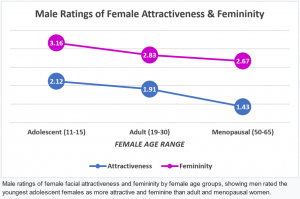
Cross-cultural, historic and species literature appears to suggest this, as put forth by Rind and Yuill. By 2019, even those engaged with pathologising and censoring pornographic media had acknowledged the prevailing and persisting appeal of teenage girls by pointing to user surveys on the world's most popular porn site.[6] Further, present-day modeling studies display a hebephilic/ephebophilic Minor-Attracted optimum for male heterosexual attraction.
- Yuill, R, and Rind, B (2012). "Hebephilia as Mental Disorder? A Historical, Cross-Cultural, Sociological, Cross-Species, Non-Clinical Empirical, and Evolutionary Review," Archives of Sexual Behavior, Jun 28 2012.
- "For example, Johnston and Franklin (1993) had subjects "evolve" a beautiful female face over iterated generations on a computer program designed to simulate natural selection. In the end, the most attractive versions of females' faces had proportions typical of girls aged 11-14. Braun, Gruendl, Marberger, and Scherber (2001) used morphing software to vary female characteristics and found that facial shapes of girls of about 14-years-old, with smooth, pure skin, produced the highest attraction ratings. They found that even the most attractive mature female faces could be made more attractive by morphing into them greater and greater degrees of immaturity. [...] The foregoing considerations suggest a range of female ages, which most typically are capable of producing adaptive attraction responses in mature males with respect to reproduction. This range extends from puberty, when reproductive value is maximal, into the 20s, when fertility is greatest, and beyond while fertility lasts. Within this range, male preferences may typically peak, for example, at female ages of 17 or 18, a compromise of highest reproductive value (ages 12 or 13) and fertility (ages 22 or 23) (cf. Williams, 1975). Depending on local social and cultural conditions, this peak may be shifted (i.e., recalibrated) to younger or older female ages (Buss, 1989)."
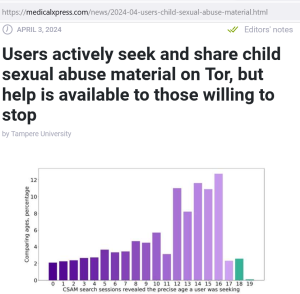
- Röder S, Fink B, Jones BC (2013). Facial, Olfactory, and Vocal Cues to Female Reproductive Value. Evolutionary Psychology. Vol 11, Issue 2.
- "Facial, olfactory, and vocal cues may advertise women's fertility. However, most of the evidence for this proposal has come from studies of changes in young adult women's attractiveness over the menstrual cycle. By contrast with this emphasis on changes in attractiveness over the menstrual cycle, possible changes in women's attractiveness over their lifespan have received little attention. The present study investigated men's ratings of young girls' (11–15 years old), adult women's (19–30 years old) and circum-menopausal women's (50–65 years old) facial, body odor, and vocal attractiveness and femininity. Faces and voices, but not body odors, of young girls and adult women were perceived to be significantly more attractive and feminine than those of circum-menopausal women. These data suggest that facial and vocal cues may be cues to women's reproductive value, but that body odor cues do not necessarily advertise this information."
Effects of perceived age on self-reported attraction
- O'Donnell et al. (2014). Heterosexual men's ratings of sexual attractiveness of pubescent girls: Effects of labeling the target as under or over the age of sexual consent, Arch Sex Behav, 43, 267–271.
- "The study aimed to identify implicit and explicit processes involved in reporting the sexual attractiveness of photographs of the same pubescent girls labeled as either under or within the age of sexual consent in the UK, women, and men. In two studies, 53 and 70 heterosexual men (M age 25.2 and 31.0 years) rated the sexual attractiveness of photographs in each category presented via computer [seeing target photographs of girls labeled as either under- (14-15 years) or within the age of consent (16-17 years)], using a 7-point response box. Ratings in Study 1 were in response to a question asking participants to rate how sexually attractive the person in each photograph was. In Study 2, participants rated how sexually attractive they personally found the target. Response times were also recorded. Several findings were replicated in both studies (although the strength of findings differed). Mean ratings of the sexual attractiveness of the underage girls were lower than those of overage girls and women. In addition, correlations revealed significantly longer responding times when "underage" girls (and men) were rated as more highly sexually attractive. No such relationship emerged with the same girls labeled within the age of consent or women. Overall, these data suggest that men find pubescent girls identified as being under the age of consent sexually attractive, but inhibit their willingness to report this; the greater the attraction, the greater the inhibition."
- Bennett, P. et al (2015). Heterosexual Men’s Ratings of Sexual Attractiveness of Adolescent Girls: A Cross-Cultural Analysis, Arch Sex Behav, 44, 2201–2206.
- "Following an identical procedure to the one we previously reported (O’Donnell, Lowe, Brotherton, & Bennett, 2014), we examined ratings of sexual attraction to photographs of (the same) adolescent girls (Tanner stages 3–4) labelled as either 14–15 years or 16–17 years old, women, and men. Ratings were made by Bulgarian heterosexual men by pressing buttons on a response box which recorded the ratings made and the time in milliseconds taken to respond. Despite the age of sexual consent in Bulgaria being 14 years, the pattern of findings did not differ from those found in the UK, where the age of consent is 16 years. That is, mean ratings of the sexual attractiveness of the girls labelled as younger were lower than those of the (same) girls labelled as older, and those of the women. In addition, correlations revealed significantly longer responding times when younger girls (and men) were rated as more highly sexually attractive. These associations were reversed in response to the photographs of women. We take these findings to indicate an inhibitory effect arising from generalized sexual norms relating to the inappropriateness of sexual attraction to young girls; the greater the attraction, the higher the inhibition. This second replication of our initial findings suggests a robust effect that may be of benefit in exploration of pedophile or sex offender groups."
Non-offending MAPs
- For estimates of "true" pedophilia among CSOs, see Offender characteristics.
We can extrapolate from phallometric studies, that equal or greater pedo/hebephilic arousal is only twice as common among child sex offenders as in the general population (around 40:20%). Seto, for example - presented two samples with a marked clinical bias (offenders referred for assessment of "sexual interest in children") and highly unrepresentative criminal offending history (since the Canadian Age of Consent was a low 14 at the time, 3 in 4 of the men had offenses involving youth under 12, when we know that a large majority of offending "against children" in the US involves teens[8]). Despite the obvious biases of the samples, using phallometry, Seto could only identify sexual preference for girls up to 12/13 in just over half of the offenders. The remainder of the offenders against pre or peri-pubertal girls showed a stronger response to adult stimulus material.[9] Similar phallometric tests documented by Seto (and others) have been conducted on the general population, with levels of preference for girls under 12/13 as high as 25%.[1]
When Seto adjusts his specificity level to assume 10% of his controls are "pedophilic", only 27% of his CSOs can be deemed pedophilic by the same standards.[10] These numbers, i.e. a doubling, at best trebling of minor attraction among CSOs, would appear to confirm the existence of numerous non-offending minor-attracted males. Even multiplying a typical 0.5% for detected CSO convictions in the general population by 10, to factor in undetected crimes, we would then end up with approximately 5% CSOs in the general male population, and therefore around 10-15% among those with a preferential attraction towards girls under 12/13. Put another way, if 90% of MAPs have offended against a child, 30-40% of men in the general population have as well, and no child is "safe".
One sample by Bailey indicated that under 1 in 5 MAPs had a CSO conviction, likely to be an overestimate for MAPs in general, as he canvassed for members of online communities in which offenders are more likely to participate.[11] These numbers were repeated by another researcher in 2018.[12]
- Hall, G.C.N., Hirschman, R., & Oliver, L.L. (1995). "Sexual Arousal and Arousability to Pedophilic Stimuli in a Community Sample of Normal Men," Behavior Therapy, 26, 681-694.
- "The current results suggest that sexual arousal to pedophilic stimuli occurs among a sizable minority of normal men who report no pedophilic behavior and is not necessarily associated with pedophilic behavior."
- Underwager, Ralph and Wakefield, Hollida (1995). "Special Problems with Sexual Abuse Cases," in J. Ziskin (ed.), Coping With Psychiatric and Psychological Testimony, Fifth Edition, pp. 1315-1370. Los Angeles, CA: Law and Psychology Press.
- "Although the terms are often used interchangeably, a distinction must be made between "sex offender against a minor" and "pedophile." The former refers to a criminal sexual behavior and the latter to an anomalous sexual preference. Many pedophiles never act on their impulses."
- Fagan, Peter J.; Wise, Thomas N.; Schmidt, Chester W.; and Berlin, Fred S. (2002) "Pedophilia," Journal of the American Medical Association, 288, 2458-2465.
- "Also, not all individuals who fulfill the diagnostic criteria for pedophilia actually abuse children."
- Freel, Mike (2003). "Child Sexual Abuse and the Male Monopoly: An Empirical Exploration of Gender and a Sexual Interest in Children," The British Journal of Social Work, 33, 481-498.
- "If someone is fully inhibited from sexually abusing children, no amount of emotional congruence, sexual arousal, or blockage will lead them to abuse children."
- Jarvik, Elaine (2007). "Teacher gets new accuser in sex case," Deseret Morning News, 17 March.
- "A person can be diagnosed as a pedophile without ever touching a child, [Dr. Mark] Zelig explains. "Our best research shows that the majority of men who have a sexual attraction to children do not act on it.""
Towards a model of impulse control
Bailey found that among identified pedophiles (while offending was very low), experiential/situational and lifestyle history features predicted offending, and "pro-contact" beliefs did not. Other studies tend to make predictable observations re. impulse control in non-offending pedophiles.
- Bailey, J. (2016). "An Internet study of men sexually attracted to children: Correlates of sexual offending against children," Journal of Abnormal Psychology, Oct 2016.
- "We conducted an Internet survey of 1,102 men sexually attracted to children concerning their history of adjudicated offenses related to child pornography and sexual contact with children. Most of the men reported no offenses, but their rate of offenses was much higher than that expected for adult-attracted men. Correlates of offending are consistent with a strong role of the cumulative effects of temptation, especially age. Older men, men who had repeatedly worked in jobs with children, men who had repeatedly fallen in love with children, and men who had often struggled not to offend were especially likely to have offended. Attraction to male children, relative attraction to children versus adults, and childhood sexual abuse experiences were also strong predictors of offending. In contrast, permissive attitudes regarding child-adult sex and frequent indulgence in sexual fantasies about children were not significantly related to offending. Our findings represent the first large study of offending among men sexually attracted to children who were not recruited via contact with the legal system."
- Seto, M. (2009). "Pedophilia," Annual Review of Clinical Psychology, 5, 391-407.
- "Yet even after thorough police and child welfare investigations, some pedophiles are found to have no history of sexual contacts with children. [...] Seto & Eke (2005) followed a sample of child pornography offenders for an average of 2.5 years. The majority of these offenders would likely be diagnosed as pedophiles (Seto et al. 2006). A small proportion (4%) committed a contact sexual offense during this time period. This suggests that having a sexual interest in children is not a sufficient factor to explain sexual offending against children. In Seto & Eke's (2005) study, child pornography offenders with any kind of prior criminal history were more likely to commit a contact sexual offense, or an offense of any kind, during the follow-up period. This finding suggests that it is the pedophiles who are more likely to engage in antisocial or criminal behavior of any kind—which would include individuals who are impulsive, callous, and willing to take risks; individuals who become disinhibited as a result of substance misuse; and individuals who endorse antisocial attitudes and beliefs such as a disregard for social norms or the laws—who pose the greatest risk of acting upon their sexual interest in children (Seto 2008). In contrast, one would predict that pedophiles who are reflective, sensitive to the feelings of others, averse to risk, abstain from alcohol or drug use, and endorse attitudes and beliefs supportive of norms and the laws would be unlikely to commit contact sexual offenses against children."
- Kärgel, C., Massau, C., Weiß, S., Walter, M., Borchardt, V., Krueger, T.H.C. … Schiffer, B. (2016). Evidence for Superior Neurobiological and Behavioral Inhibitory Control Abilities in Non-Offending as Compared to Offending Pedophiles. Human Brain Mapping, 00(00), 1-13.
- "Neurobehavioral models of pedophilia and child sexual offending suggest a pattern of temporal and in particular prefrontal disturbances leading to inappropriate behavioral control and subsequently an increased propensity to sexually offend against children. However, clear empirical evidence for such mechanisms is still missing. Using a go/nogo paradigm in combination with functional magnetic resonance imaging (fMRI) we compared behavioral performance and neural response patterns among three groups of men matched for age and IQ: pedophiles with (N=40) and without (N=37) a history of hands-on sexual offences against children as well as healthy non-offending controls (N=40). As compared to offending pedophiles, non-offending pedophiles exhibited superior inhibitory control as reflected by significantly lower rate of commission errors. Group-by-condition interaction analysis also revealed inhibition-related activation in the left posterior cingulate and the left superior frontal cortex that distinguished between offending and non-offending pedophiles, while no significant differences were found between pedophiles and healthy controls. Both areas showing distinct activation pattern among pedophiles play a critical role in linking neural networks that relate to effective cognitive functioning. Data therefore suggest that heightened inhibition-related recruitment of these areas as well as decreased amount of commission errors is related to better inhibitory control in pedophiles who successfully avoid committing hands-on sexual offences against children."
Excerpt Graphic Library
The EGL on Prevalence has some relevant information. Just right click/save and reproduce by uploading in short-form media to bypass character limits.
-
A comparison of various phallometric studies
-
Phallometric studies establish hebephilic interest as normative, pedophilic as common
-
(Continued) Prevalence of pedophile feelings 20% of men, even in self-reports
-
Tromovitch Presentation (using inclusivist/nonpreferential definition of pedophilia)
-
Tromovitch Presentation (cont'd)
-
Freund and Costell (1970) - showing prevalence of heterosexual pedophilic and hebephilic response
-
Freund and Costell (1970) alternative version: arousal levels to nude images
-
Hebephilia is universal (see characteristics and the associated article for more excerpts)
-
Search results suggest hebephilia is common
-
...as do porno trends
-
...as do historical marriage trends
-
Example RV curve
-
Roder (2013) attractiveness and femininity ratings by age
-
Preference for neotenic features is common
-
Non-offending pedophilia and impulse control
References
- ↑ 1.0 1.1 1.2 Schuster - "Every Fifth" Combination of Studies
- ↑ Erotic Innocence - The Culture of Child Molesting by James R. Kincaid; Duke University Press, Durham, North Carolina, USA; Paperback edition: 2000; First edition: 1998
- ↑ DSM-5 or Exact Copy (paraphilia) or Exact Copy (pedophilic disorder).
- ↑ BBC Quote Seto on 5% upper estimate.
- ↑ One in 10 Australian men report having sexual contact with under-18s, study finds
- ↑ “Teen”: Why Has This Porn Category Topped the Charts for 6+ Years?
- ↑ Users actively seek and share child sexual abuse material on Tor, but help is available to those willing to stop - MedicalXpress
- ↑ Finkelhor, D., Shattuck, A., Turner, H., Hamby, S. (2014). The lifetime prevalence of child sexual abuse and sexual assault assessed in late adolescence. Journal of Adolescent Health; 55(3): 329-333
- ↑ Seto, M. C., Harris, G. T., Rice, M. E., & Barbaree, H. E. (2004). The Screening Scale for Pedophilic Interests Predicts Recidivism Among Adult Sex Offenders with Child Victims. Archives of Sexual Behavior, 33(5), 455–466.
- ↑ Seto, M. C., & Lalumière, M. L. (2001). A Brief Screening Scale to Identify Pedophilic Interests Among Child Molesters. Sexual Abuse: A Journal of Research and Treatment, 13(1), 15–25.
- ↑ Bailey, J. M., Bernhard, P. A., & Hsu, K. J. (2016). An Internet study of men sexually attracted to children: Correlates of sexual offending against children. Journal of Abnormal Psychology, 125(7), 989–1000.
- ↑ Martijn, Frederica (2018/08/29) Experiences of sexual and romantic attraction to children and/or adults in persons with pedohebephilia
